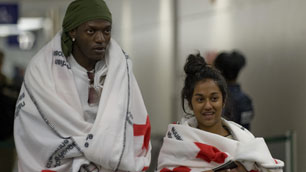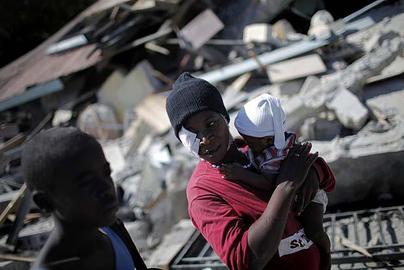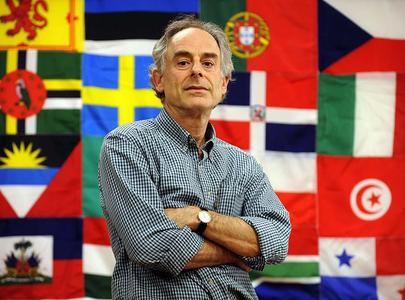Canada considers fast-tracking Haitian immigration
The Canadian government says it is looking into a plan to help fast-track immigration from Haiti in the wake of the earthquake that has crippled the Caribbean country.
Prime Minister Stephen Harper said Thursday he and Immigration Minister Jason Kenney have been discussing ways to ease immigration and refugee rules to allow more Haitians into Canada quickly.
Opening up the process “will be something the government will be addressing in the next couple of days,” he said while stopping at the Ottawa Red Cross office to make a donation.
The first three military air transports arrived in Montreal from Haiti early Friday morning, carrying 272 evacuees who had been selected by staff at the Canadian Embassy for transport, Foreign Affairs Minister Lawrence Cannon said Friday.
The latest Canadian consular information has confirmed four Canadians have died, 13 are reported injured and an additional 550 have been located, Cannon said. About 1,415 Canadians living in the affected area are still missing, he said.
About 6,000 Canadian citizens live in Haiti, but only 700 were registered with the embassy in Port-au-Prince, said Foreign Affairs Minister Lawrence Cannon.
The Canadian Embassy has continued to be a refuge for citizens, however, and many are being sent to Santo Domingo in the Dominican Republic for transport back to Canada.
But as the situation for people in Haiti worsens, the government is expected to look at a plan that would allow Haitians with Canadian relatives to also come to Canada.
Chantal Barratteau, a Haitian community organizer in Montreal, says deciding who can come and who can stay will be a difficult task.
“How can you choose who to bring here?” she asks. “I mean if I could choose, I would bring my family if they are hurt, and then my neighbours, and then my family’s friends and so on.”
Thousands of Haitians spent another night outside following the 7.0- magnitude quake that hit the country this week. Many won’t return to their homes, fearing that continuing aftershocks will knock down already weakened structures.
Take our FREE Online Assessment Today!
Socialize with Abrams & Krochak
First wave of evacuees from Haiti headed to Canada
Socialize with Abrams & Krochak
Canada responds as 100,000 feared dead
The defence department’s Disaster Assistance Relief Team will deploy to Haiti, Defence Minister Peter MacKay announced Wednesday, following Tuesday’s deadly earthquake.
The only question is when and how to balance the need for medical professionals to treat the sick and wounded against the need for engineers and infrastructure specialists who can prop up damaged bridges and buildings in a land where flimsy construction standards were no match for the sliding tectonic plates.
“We do have soldiers at Petawawa obviously ready to deploy,” MacKay said.
“Numbers, personnel, equipment ready to go, we do have people standing up, getting ready for those deployments and as information becomes available we’ll make the decisions.”
DART is a group of 200 Canadian soldiers specially trained to enter disaster areas around the world and provide drinking water and medical treatment until long-term aid arrives.
There are 750 Canadians said to be living in Haiti, including 82 police officers, seven corrections officers and five Canadian Armed Forces personnel deployed as part of the United Nations stabilization mission in Haiti.
A Kitchener-Waterloo area nurse has been confirmed among the casualties of the earthquake. A Kitchener-Waterloo area nurse has been confirmed among the casualties of the Haiti earthquake.
The woman arrived in Port-au-Prince Tuesday as part of a team of seven Evangelical Missionary Church of Canada nurses to provide medical clinics, said Global Initiatives director Lou Geense.
“It’s pretty hard to grab a hold of,” said Geense. “Not only for our loss but the loss of hundreds and thousands of Haitian people and the people that we work with there.”
The identity of the woman is being withheld pending approval of the victim’s family. All six surviving members of the group, all from southern Ontario, are safe, said Geense.
The RCMP has released the names of two Mounties still not accounted for. They are RCMP Superintendent Douglas Coates (from Ottawa) and RCMP Sergeant Mark Gallagher (Halifax).
“Our thoughts and prayers go out to both officers and their families for their safe return. We would request that the media respect the privacy of both families during this difficult time.,” the RCMP said in a news release today.
Officers from municipal partner agencies across Canada as well as federal RCMP make up the Canadian deployment to Haiti – Canada’s largest overseas police mission. It is mandated for up to 100 officers, and the 82-officer contingent currently includes 13 Mounties. It is largely a Francophone crew, and they are stationed in areas all over Haiti, she said.
“We’re working closely with police and government partners to account for all Canadian police officers who have been deployed, that includes our partner agencies as well,” said RCMP Sgt. Pat Flood. “Our priority is the security and safety of our members in mission and providing support to their families here in Canada.”
“Canadian citizens continue to take refuge in the embassy compound. Tents, food, water as well as medical assistance are available on site,” Foreign Affairs Minister Lawrence Cannon said.
Haiti’s president, Rene Preval, said he believes thousands of people were killed in Tuesday afternoon’s magnitude-7.0 quake, and the scope of the destruction prompted other officials to give even higher estimates. Leading senator Youri Latortue told The Associated Press that 500,000 could be dead, though he acknowledged that nobody really knows.
Ottawa earlier announced Canada is contributing an initial $5 million to relief efforts and expects to dispatch life-saving supplies to Haiti.
A senior Canadian official will also head the International Red Cross’s relief efforts in the island nation.
“We are deeply concerned about the impact of this disaster on the people of Haiti,” said International Development Minister Bev Oda in a conference call from Bolivia with reporters.
Oda was to have made a stop in Port-au-Prince after her tour in the South American country. Instead she will be coordinating Canada’s response to the 7.0 quake, which is expected to have killed thousands.
The emergency cash infusion will go through multilateral aid groups on the ground in Haiti to provide emergency shelters, medicine, food relief and protection in the poorest country in the hemisphere. It will also fund a field hospital that the Red Cross is setting up along with funding from the Norwegian government, Oda said.
Liberal leader Michael Ignatieff immediately called for more aid, saying that $5 million is a good start, but urging Ottawa to dig deeper.
Speaking to University of Toronto students this morning, Ignatieff also said Canada should make changes to speed up its visa process to help families get relatives out of the devastated country. Prime Minister Stephen Harper spoke Wednesday with Nathalie Gissel-Menos, Haiti’s head of mission in Ottawa, and offered both Canada’s sympathy and assistance, said a spokesman for the government.
“This natural disaster has hit a country with an extremely fragile infrastructure, where many buildings are already unstable, and where living conditions are often very difficult. I fear for its people,” Governor-General Michaëlle Jean, who was born in Port-au-Prince, wrote inher blog today.
“I would like all Haitians to know that they are not alone and that the people of Canada will respond to this emergency.”
Toronto Mayor David Miller said in a statement that members of the city’s Office of Emergency Management and the HUSAR (Heavy Urban Search and Rescue) team are standing by to help.
“On behalf of all Torontonians, I extend deepest condolences and sympathies to Toronto’s Haitian community and especially to those with family and friends in the areas devastated by yesterday’s earthquakes and today’s aftershocks,” he said. Miller has contacted the honourary Haitian Consul General in Toronto to determine how Torontonians can assist and he has asked Toronto’s Office of Emergency Management to determine the best way for the city to coordinate relief efforts, the statement said.
Oda also spoke with the Canadian ambassador in Port-au-Prince on Wednesday, and she said the embassy in the capital has suffered damage. A senior Canadian Red Cross official will head the humanitarian agency’s international team being airlifted in earthquake-ravaged Haiti.
Jean-Pierre Tachereau, who heads emergency response for the Canadian Red Cross, said the situation on the ground is still uncertain because the power grid has failed and the agency is only getting bits and pieces of information.
He said the initial Red Cross team will include about 60 volunteers from 10 different countries.
In Ottawa, a government task force has been established to coordinate the activities of the government’s aid agency, the military and the foreign ministry.
That group is waiting for an initial assessment of the help required from aid groups that is expected to arrive later Wednesday. Meanwhile, Oda said a stockpile of relief equipment in Canada is ready to go but will be delayed until a thorough calculation of the humanitarian needs is completed.
The delay, though counterintuitive in the wake of such a disaster, flows from the world’s response to the Asian tsunami on Boxing Day 2005.
“One thing that the international community learned as a consequence of the tsunami is that if you take a little time to ensure coordination that the proper supplies and the quantity or number of the supplies is going to be in country as it’s needed,” she said.
In the world’s response to the tsunami, “everyone just assumed” their humanitarian assistance and relief supplies were needed without checking with aid workers on the ground.
“There were supplies that were needed that weren’t being provided and there was an overabundance and surplus that couldn’t be distributed in a reasonable manner,” Oda said.
Earlier, Canada’s Foreign Affairs Minister said a reconnaissance team would leave immediately to clear the way for the full Disaster Assistance Response Team (DART).
DART is a group of 200 Canadian soldiers specially trained to enter disaster areas around the world and provide drinking water and medical treatment until long-term aid arrives.
In addition to advance teams and DART, a C-17 aircraft full of medical aid and a pair of search-and-rescue helicopters will be sent.
“An inter-departmental strategic support team is also in route to Haiti to conduct a humanitarian needs assessment and identify action that Canada can take to support the relief and recovery efforts,” Cannon said.
Community efforts are already underway in Montreal, home to more than 100,000 Haitian immigrants.
“(An emergency committee) will be set up this morning with representatives of the government of Quebec and the Haitian community, to see what will be the priorities, what we can send, how we’ll co-ordinate with the federal government, and with Canadians who will be arriving in Haiti,” said Junia Barreau, vice-consul of the Consulate General of Haiti in Montreal.
Take our FREE Online Assessment Today!
Socialize with Abrams & Krochak
Visa clampdown near for Hungarian visitors
OTTAWA–Ottawa is seriously considering imposing visa requirements on visitors from Hungary to cut off a growing flood of refugee applicants, mainly from its Roma community, The Canadian Press has learned.
It would be the third such move in less than a year, after Canada imposed visas on visitors from Mexico and the Czech Republic last summer.
Such a decision could provoke retaliation not just from Hungary, but also the much larger and more powerful European Union, which already has protested the clampdown on Czech travellers.
The number of refugee claims from Hungary has soared since last spring, according to data collected by Canada’s Immigration and Refugee Board.
That’s despite months of attempts by Hungarian and Canadian officials to find other ways to better manage the influx.
Numbers began to rise after Canada lifted visa requirements in the spring of 2008, when Hungary joined the European Union. Since the spring of 2009, however, the steady increase turned into a flood.
Immigration Minister Jason Kenney visited Budapest last June and urged his Hungarian counterparts to take steps.
“He raised Canada’s concerns about the growing number of asylum seekers going to Canada,” said Kenney’s spokesman Alykhan Velshi.
Velshi said efforts to collaborate had not produced concrete results. “Thus far, unfortunately, the number has gone up.”
Now, the Eastern European country is among the top three sources of refugee claimants. Claims made every month usually were between 20 and 40 right after the visa requirement was lifted in the spring of 2008. By the fall of 2009, the monthly total was around 200.
Numbers for the final three months of the year have not yet been made public but are expected to show another sharp increase.
At the same time, the board’s approvals of claims have plunged to zero, with many claimants withdrawing or abandoning their claims as they come up for processing.
Velshi said explanations for the spike include: a growing willingness to abuse Canada’s visitors’ process; an increase in human trafficking; or an increase in unscrupulous immigration consultants.
“All of these problems, it’s the responsibility of the Hungarian government to look into,” Velshi said.
That’s not the way Hungary sees it.
The Hungarian government allows its citizens to move about freely, said Imre Halyes, head of consular affairs at the Hungarian embassy in Ottawa. So, if Canada’s refugee system has loopholes inviting abuse, it’s up to Ottawa to fix.
Paul St. Clair, executive director of the Roma Community Centre, in Toronto says Canada should not consider Hungarian refugee claims baseless because Roma are fleeing a “pretty disgusting fascist revival” in Hungary and people are only starting to discover how best to apply for asylum here.
Take our FREE Online Assessment Today!
Socialize with Abrams & Krochak
Archives
- June 2025
- March 2025
- February 2025
- December 2024
- October 2024
- June 2024
- May 2024
- April 2024
- January 2024
- November 2023
- July 2023
- June 2023
- May 2023
- January 2023
- November 2022
- April 2022
- March 2022
- February 2022
- October 2021
- June 2021
- April 2021
- October 2020
- September 2020
- June 2020
- May 2020
- April 2020
- March 2020
- December 2019
- January 2019
- December 2018
- November 2018
- August 2018
- June 2018
- April 2018
- January 2018
- December 2017
- November 2017
- April 2017
- January 2017
- December 2016
- November 2016
- October 2016
- September 2016
- August 2016
- August 2015
- January 2015
- December 2014
- November 2014
- June 2014
- April 2014
- March 2014
- February 2014
- December 2013
- May 2013
- April 2013
- January 2013
- December 2012
- August 2012
- June 2012
- March 2012
- January 2012
- September 2011
- August 2011
- July 2011
- June 2011
- February 2011
- January 2011
- December 2010
- November 2010
- September 2010
- August 2010
- July 2010
- June 2010
- May 2010
- April 2010
- March 2010
- February 2010
- January 2010
- December 2009
- November 2009
- October 2009
- September 2009
- August 2009
- August 2008
- July 2008
- June 2008
- May 2008
- April 2008
- March 2008
- February 2008
- January 2008




